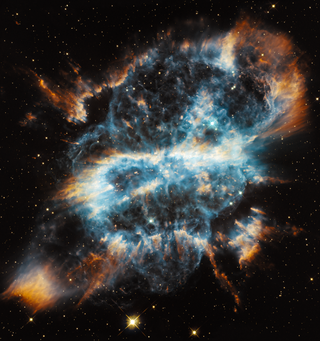
NGC 5189 is a planetary nebula in the constellation Musca. It was discovered by James Dunlop on 1 July 1826, who catalogued it as Δ252. For many years, well into the 1960s, it was thought to be a bright emission nebula. It was Karl Gordon Henize in 1967 who first described NGC 5189 as quasi-planetary based on its spectral emissions.

A Wolf–Rayet nebula is a nebula which surrounds a Wolf–Rayet star.
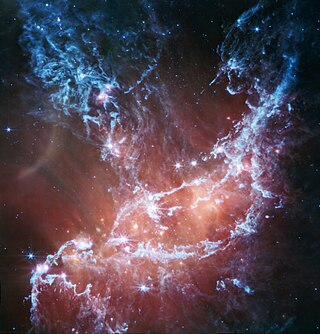
NGC 346 is a young open cluster of stars with associated nebula located in the Small Magellanic Cloud (SMC) that appears in the southern constellation of Tucana. It was discovered August 1, 1826 by Scottish astronomer James Dunlop. J. L. E. Dreyer described it as, "bright, large, very irregular figure, much brighter middle similar to double star, mottled but not resolved". On the outskirts of the cluster is the multiple star system HD 5980, one of the brightest stars in the SMC.

NGC 2359 is an emission nebula in the constellation Canis Major. The nebula is approximately 3,670 parsecs away and 30 light-years in size. The central star is the Wolf-Rayet star WR7, an extremely hot star thought to be in a brief pre-supernova stage of evolution. It is similar in nature to the Bubble Nebula, but interactions with a nearby large molecular cloud are thought to have contributed to the more complex shape and curved bow-shock structure of Thor's Helmet.

WR 136 is a Wolf–Rayet star located in the constellation Cygnus. It is in the center of the Crescent Nebula. Its age is estimated to be around 4.7 million years and it is nearing the end of its life. Within a few hundred thousand years, it is expected to explode as a supernova.

WR 7 is a Wolf–Rayet star in the constellation of Canis Major. It lies at the centre of a complex bubble of gas which is shocked and partially ionised by the star's radiation and winds.

NGC 371, also called Hodge 53, is an open cluster 200,000 light-years away located in the Small Magellanic Cloud in Tucana constellation.
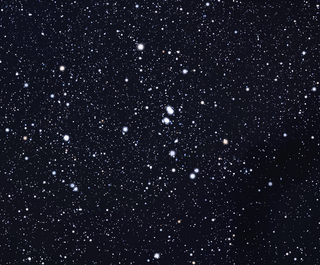
NGC 6871 is a small, young open cluster in the constellation of Cygnus. The cluster has fewer than 50 members, most of which are blue and white stars. It is located 5135 light-years from Earth.
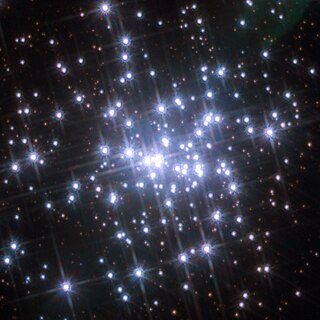
NGC 3603-B is a Wolf-Rayet star located at the centre of the HD 97950 cluster in the NGC 3603 star-forming region, about 25,000 light years from Earth. It has the spectral type WN6h and is among the most luminous and most massive stars known.

NGC 1501 is a complex planetary nebula located in the constellation of Camelopardalis, it was discovered on the 27th August 1787 by William Herschel. It is also known as the Oyster Nebula.
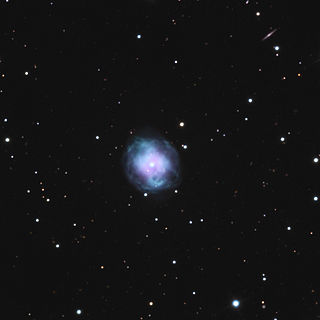
NGC 4361 is a planetary nebula in the constellation of Corvus. It is included in the Astronomical League's Herschel 400 Observing Program.
BAT99-98 is a star in the Large Magellanic Cloud. It is located near the R136 cluster in the 30 Doradus nebula. At 226 M☉ and 5,000,000 L☉ it is one of the most massive and luminous stars known.

WR 42e is a Wolf–Rayet star in the massive H II region NGC 3603 in the constellation of the Carina. It is around 25,000 light-years or 7,600 parsec from the Sun. WR 42e is one of the most massive and most luminous stars known.
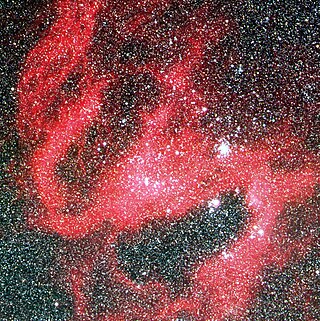
LMC195-1 is a Wolf–Rayet star located in the Large Magellanic Cloud (LMC). It is an extremely rare member of the WO oxygen sequence, at WO2 the hottest known in the LMC. It is likely to be one of the hottest stars known.

LH 41-1042 is a Wolf–Rayet star located in the Large Magellanic Cloud (LMC). It is an extremely rare member of the WO oxygen sequence, the second to be discovered in the LMC and one of only three found so far in that galaxy.
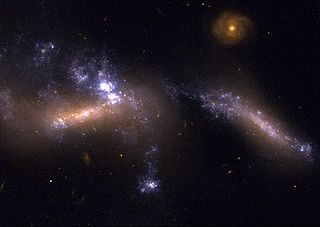
NGC 1741 is a distant pair of interacting galaxies in the Eridanus constellation. It was discovered on 6 January 1878 by French astronomer Édouard Stephan. As a result of the collision, the galaxies are in a rapid starbust phase. The galaxies are classed as Wolf–Rayet galaxies due to their high content of rare Wolf–Rayet stars.

NGC 1140 is an irregular galaxy in the southern constellation of Eridanus. Estimates made using the Tully–Fisher method put the galaxy at about 59 million light years. It was discovered on 22 November 1786 by William Herschel, and was described as "pretty bright, small, round, stellar" by John Louis Emil Dreyer, the compiler of the New General Catalogue.

NGC 3199 is an emission nebula in the constellation Carina. It is commonly known as the Banana Nebula. The object was discovered in 1826 by the Scottish astronomer James Dunlop. It was thought to be the bow shock around the central star, WR 18, an especially hot and luminous Wolf–Rayet star; however, it was determined that the nebula formed due to the composition of local space, not because of the star's movement.
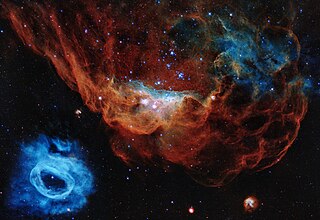
NGC 2014 is a red emission nebula surrounding an open cluster of stars in the Large Magellanic Cloud, at a distance of about 163,000 light-years.
NGC 6822-WR 12 is a WN-type Wolf-Rayet star located in the galaxy NGC 6822, about 1.54 million light years away in the constellation of Sagittarius. NGC 6822-WR 12 was the first Wolf-Rayet star to be discovered in the galaxy, and is one of only four known in the galaxy.

















